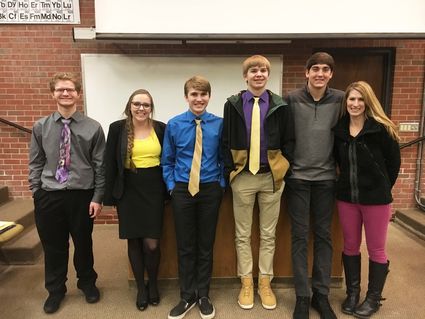Big Sandy students win honors at regional Science fair
March 13, 2019

Science students, l to r: Everett Works, Hope Gasvoda, Tyler Schwarzbach, Ryan Roth, Clint Darlington, and Teacher Melanie Schwarzbach.
Five Big Sandy High School students competed in the Hi-Line Regional Science Fair at MSU Northern on March 5th.
Hope Gasvoda, a junior, will be representing the Hi-Line at the Intel International Science and Engineering Fair (ISEF) in Phoenix this May. Her projected, entitled "Comparing the Glucose Content in Lignocellulosic Biomass Produced by Cellulase Across Six pH Buffers", determined the optimum pH level for breaking down the complex sugars found in barley straw. These complex sugars break down to glucose, which in turn is the simple sugar used to make the biofuel ethanol. Her research is important, as it provides a pathway to break down complex sugars using enzymes, versus adding heat energy. This saves energy input costs and enzymes are recoverable and can be used again.
Tyler Schwarzbach, a two-time Intel ISEF finalist, took second with his project, "Glyphosate Concentration in Snow as Related to Source Region". Tyler learned that glyphosate, the active ingredient found in herbicides like Roundup, has found its way into the snow that falls on us every winter. He based his research off past studies showing the chemical has been found in rainwater, but little research had been done on snow. He also learned that weather fronts carrying snow from Canada seem to contain higher concentrations of glyphosate than those fronts coming from the south and east. While glyphosate is in our snow, most concentrations ranged between 1 and 2 parts per billion. The US EPA has deemed 30 parts per million is safe exposure level for humans.

Junior scientist Ryan Roth took third place with his project, "Removing Nitrates from Water Using Resin". Ryan created his own water filtration system, which lowered nitrate concentrations in water. This proves promising as nitrate contaminations in reservoirs plagues ranchers every summer.
Clint Darlington studied "The Effects of Carbon Nanotubes on the Growth Rates of Plants". His project attempted to reduce carbon emissions in the atmosphere, while providing an added boost to plant growth. His research was patterned after work done by a scientist from Canada who designed carbon capture systems for tractor exhaust systems. This technology has been used by some farmers in this area.
Everett Works combined his of two favorite interests: psychology and video gaming into a project titled "The Difference in Frustration Levels between Age and Gender". He had test subjects play the game "Minesweeper", the famous and notoriously frustrating computer game found on early PC's. He compared their baseline levels of frustration before and after playing the game. He found that young adult men became the most frustrated by the game, which was different than he expected.
Teacher and fair director, Melanie Schwarzbach, reported that the kids presented very well. This was the first year that Big Sandy students were the only high school competitors at the fair. Low turnout numbers are worrying,
as the future of the fair's relationship with the Intel ISEF is uncertain. The number of delegates to ISEF is determined by the size of the geographical area served by the fair, the number of schools who could participate, the number of schools who actually participate and the number of projects represented at the fair. This year, our fair was only allowed to send one project, down from two projects the last several years. Many high schools are dropping science fair as dwindling enrollment and competition from activities are pulling students in other directions. The other issue the schools in our region face is the lack of experienced teachers. Some schools are seeing a turnover in science teachers every year. Just as it's difficult to build an athletic program replacing the coach every year, the same holds true for a science research program. The future of research in Big Sandy may shift to a more individualized program, but will likely continue for highly motivated students.
The students will compete next at the state science fair, held at the University of Montana in Missoula.
